My mother grew tired one day of my morning antics. She was not just my perfect Mother Hostess, hosting my every morning breakfast before school; she also worked fulltime and had to get out the door and on her way. You see, she was not known for her patience, although she was kind about it, and I, in truth, was not known to be punctual—in fact my problem was a clear and intentional avoidance of timeliness that was thought to have been inherited from my grandmother, her mother in law. I was a dawdler, as Mother would say. (Miss Cassette has heard this repeated throughout her life from others, although not always such a nice phrasing, so it surely is true.) On this particular morning I could not be rushed along or cajoled into much of anything, let alone breakfast. I might have been acting like something of a difficult child. We finally agreed upon her offer of a half grapefruit with the individual sections cut, sugar sprinkled about, with a maraschino cherry on top. There was so much sugar being sprinkled on everything back then. I was finally content and nestled in at the kitchen table with my grapefruit. My mother then began reading from a new chapter of my Nancy Drew book.
I don’t know if she found the books or I found the books. I still think about how very lucky I was to have my mother read to me from the Nancy Drew series as I ate my breakfast in those years. Not just the luxury of being doted over by Mom but the early inspiration to be a girl detective at such a young age. My mind would wander off into those mysteries and savor that time sleuthing in my daydreams–dawdling, maybe, to everyone else. I was late almost every day to elementary school, even though our home was just a short distance away, because there was so much to be inspected on that walk. The teachers never understood. I can admit Nancy Drew was a prime influence in my life. My friends and I would ramble all over Benson, looking for secrets and clues in our self styled detective club. We knew every dirt bike trail, fort, Hells Angel hangout and abandoned apartment building. Thankfully I grew up in a time when children were allowed to wander and explore, gathering hours of essential evidence without parents hounding us for our whereabouts. I thought I knew Benson like the back of my hand.
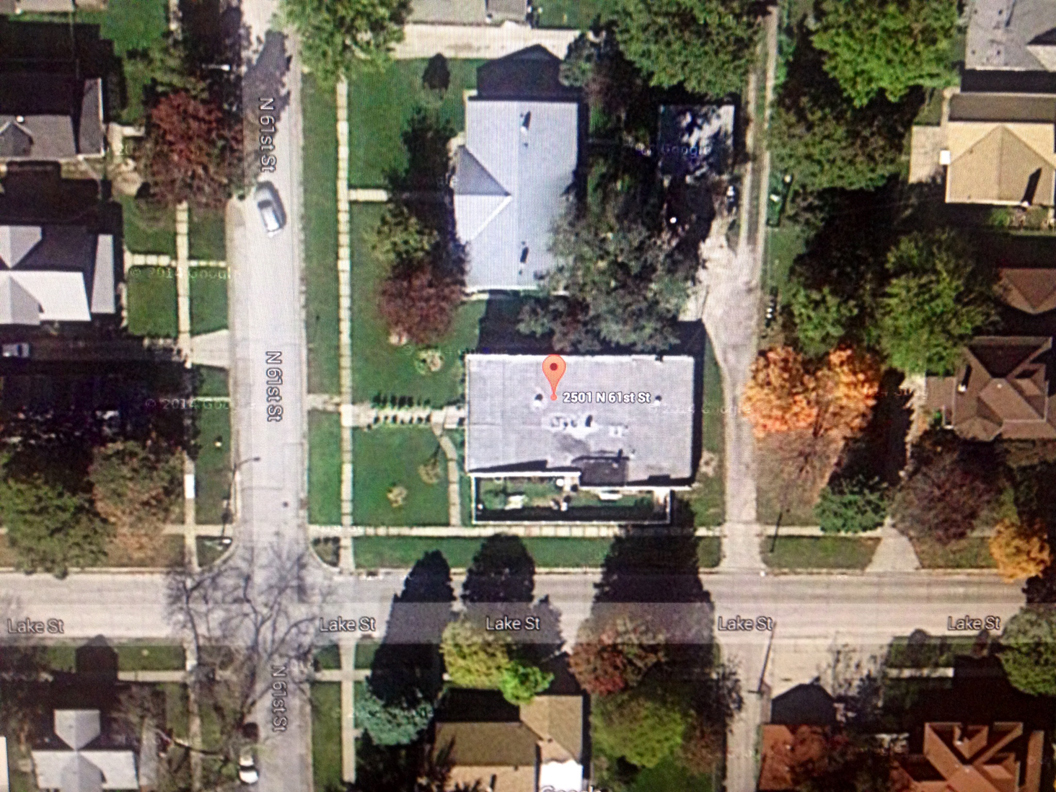
Aerial view
And that is where you come in or rather, where this Benson Mystery begins. Just a short time after beginning my blog, a friend of mine contacted me stating that her friends had recently bought an old building in Benson and were hoping to turn it into their home: 2501 North 61st Street. Plain as day, this long brick and stucco structure sits out in the open on a treeless lot, on the corner of 61st and Lake and yet, somehow, I had never seen it. (Honestly, I now wonder if our detective club ever really made it south of Maple Street?) The couple wondered if I could look into the building’s history. I was sent the below photo, which shows the concrete plaque on the front side of the building.

Owner’s photo of the cornerstone
I was immediately intrigued. I have always loved quirky, little buildings in the middle of residential neighborhoods. Part of the mystery was the fact that this unassuming premises announced its importance with a proper cornerstone—the kind of stone laid at a formal ceremony. Since when does an amateur architectural sleuthhound get handed these goods? It read “Laid by W.O.W. Benson Camp 288, Oct. 5, 1913.” It appeared by the font and the style of the cornerstone that it certainly could have been from 1913 but I was unsure if the plaque had been moved to this 61st Street location from its original. I was off and running. Unbeknownst to me, I would be running for many, many weeks until I uncovered the truth and quite remarkable history of 2501 North 61st Street.
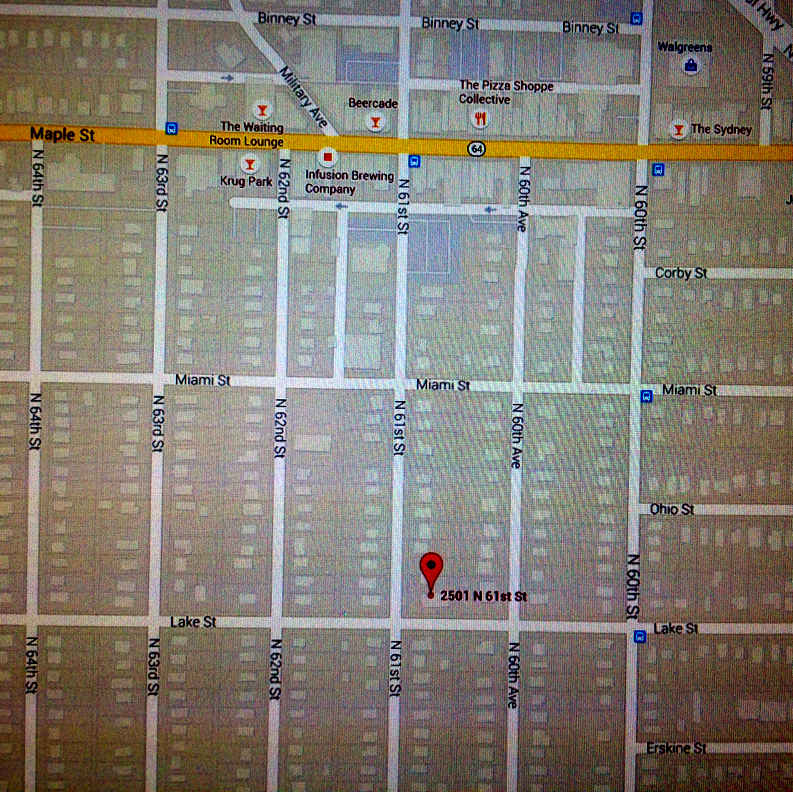
Google street map
The Early Search
During this period I spent some considerable time casing the joint, as they say. The building had some treatments that were certainly in line with a structure built in the teens. Aside from the brick part of the building in front, which appeared more proper, I assumed the stucco portion the back had been an addition. It was irregular in size. Had there actually been a number of additions? On the southern side there was long, white privacy fence, which I surmised was added by someone who had made the building into a home. There was an alley that ran behind the structure. Have we talked about how much I love alleys? I am very keen on them, especially hidden ones that have been overrun by grass.
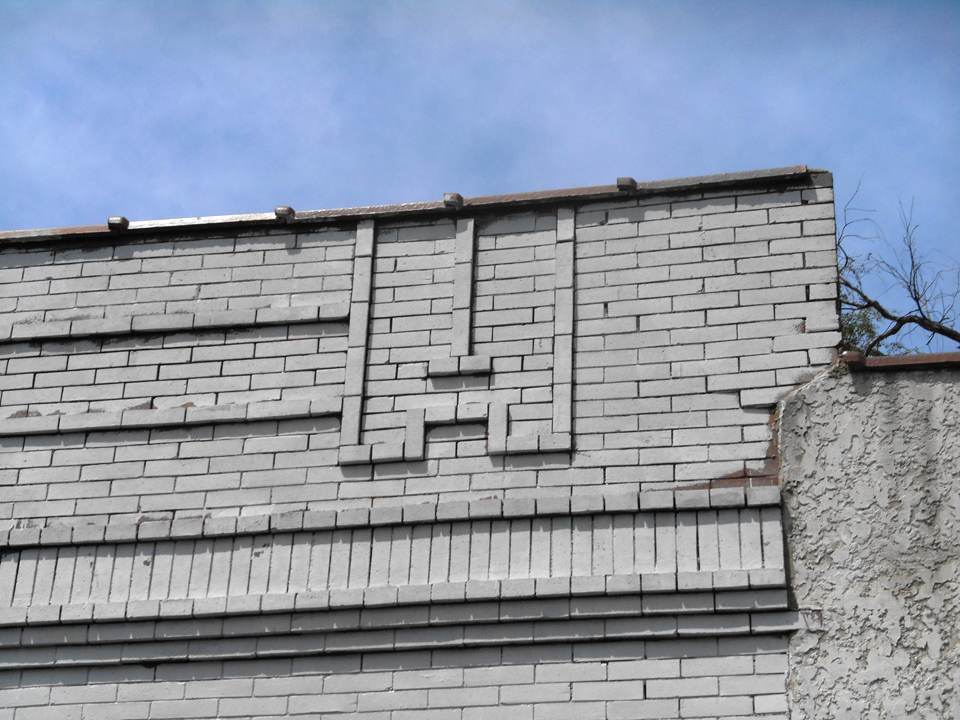
Detail
According to numerous real estate sites, 2501 North 61st Street was a 3,260 sqft masonry building with a flat roof. With one bedroom and one bathroom, the construction offered three rooms total. You should know at this point, that these are Mr. Cassette’s ideal living conditions. He much prefers the open range of a warehouse-wall-less, art studio, workspace-home or even a field of tall grasses would keep him happy. I found it odd that 2501 North 61st was listed as having a fireplace. The lot is 8,960 sqft and in fitting with the concrete plaque photo I was sent, the building was said to have been erected in 1913. I was perplexed that it was listed as a one story single-family residence. One site even listed it as two apartments for lease. Either way I looked at it, it seemed odd that a building of this type would be in a residential neighborhood. It reminded me of a small neighborhood grocery store or those pretend houses that are really just built around a utility station. It was too proper and stately, from my perspective, for either to be true.

Looking at the Douglas County Assessor I could see the floor plan of 2501. According to the assessor, it had been built in 1913 and had not been remodeled since then. Their site also verified the square footage and that there was a fireplace. In my experience, I have often found the county assessor site to list incorrect data. It just served as more information but I knew I would have to work harder to root out the facts.
If the cornerstone plaque was at all accurate, I knew that 2501 was built when Benson was its own town. The city of Omaha annexed the town of Benson by 1917. Currently 61st Street runs north and south, with Miami and Lake Streets book-ending the city block. Sitting just two blocks south of Maple Street in downtown Benson, the 2501 building is in the Halcyon Heights subdivision. I was interested to find that 61st Street had, at one time, been called Halcyon Avenue and that Maple Street had been Mayne Street or Main Street in its past. I was able to verify this when I found a map from the 1912 town of Benson telephone directory, where Halcyon Heights was depicted, along with numerous other subdivisions, to have sprung up on the edges of Benson proper. I knew from this map, that 2501 most likely started life on Halcyon Ave.
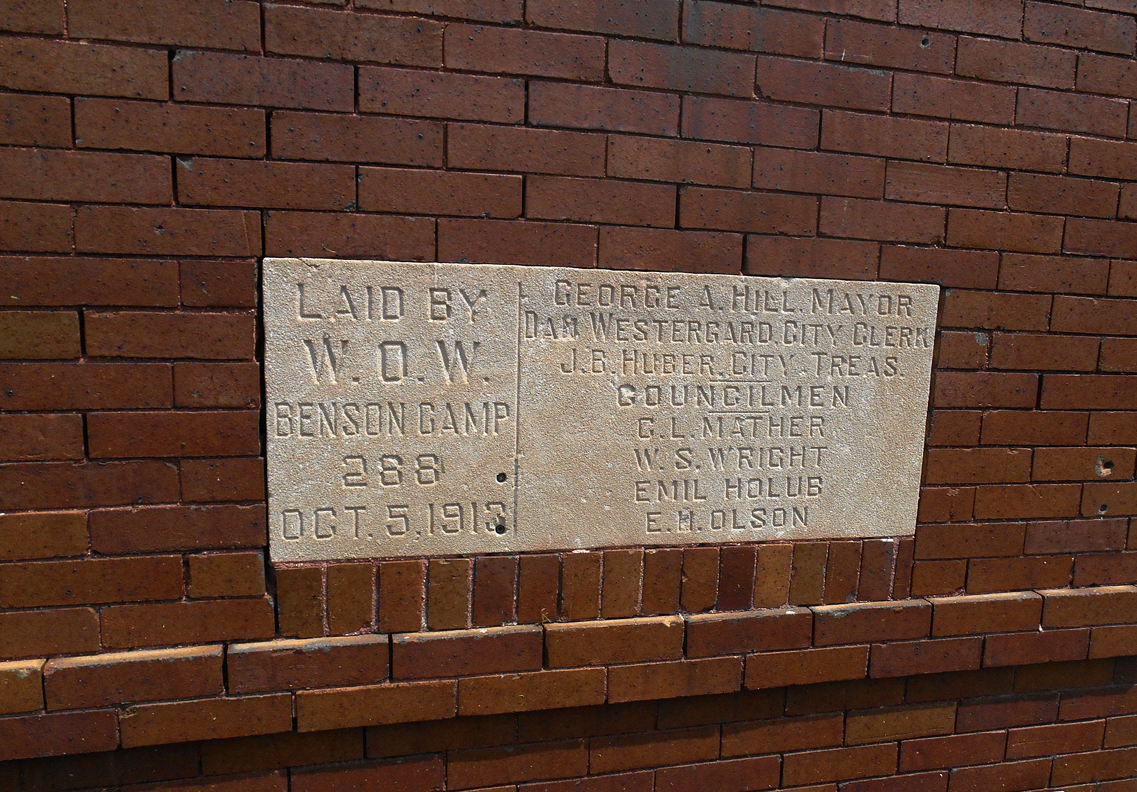
When I had first read W.O.W. Benson Camp 288 on the cornerstone, I immediately thought of the military—like a military encampment. The building didn’t seem to lend itself to this sort of meeting of troops but then again it did kind of remind me of that Veterans of Foreign Wars Post on 33rd and Leavenworth. Maybe a camp was the same as a post—just another insider military reference? I also thought about it, perhaps, referencing a camp for kids. I also had a hunch that W.O.W. stood for Woodmen of the World, which in turn, reminded me of the radio station from my childhood. I figured that my detective trail would soon lead me to research Woodmen of the World and their camp (s).
My search began in full at the W. Dale Clark Library, where I soon became frustrated. The 1917 and 1918 city directories offered no 2501 North 61st Street address. Benson must have changed to number streets once they were annexed because there was no mention of Halcyon Avenue. There was a 61st Street leading through Benson, with the appropriate cross streets. I flipped through each directory all throughout the 1920’s as well. I couldn’t understand what I was finding. There were nearby home addresses that came, went and changed through the years. I hadn’t seen that much change in a city block’s addresses in all of my architectural investigations. It was as if 2501 North 61st Street was a ghost property with a strong perimeter. Something was within that parcel boundary; I just couldn’t find it….yet.
1918: No address listed. The closest home was 2505 but it was “vacant.”
1919: No Book
1920: No address. 2503 listed under Nelson Rassmussen. 2504 under J.A. Himelrich.
1921: No Address for 2501. 2503 is listed as Gust Romstedt Soft Drinks, 2504 is listed under L.W. Chadwell
1922: No Book
This continued on. I won’t bore you with the continued details. I was slowly going mad in the stacks. I knew I would have to ask one of the research librarians for help at this point—something akin to cheating in my obsessive gumshoe mind. I asked if there was a Benson City Directory in the archives. No, there is not one. I went back to the stacks, feeling a bit snookered but almost with a renewed step as I sometimes like to hear the word “No.” My suspicions, at this point, were that 2501 North 61st Street was not build yet. I imagined there be an empty lot on 61st or that the address had changed over the years. I had seen that in past mysteries. I began to wonder, again, if that cornerstone had been moved from the previous W.O.W. Benson Camp site, which apparently was from 1913.
It wasn’t until 1931 that I found my first solid clue. 2501 had its introductory appearance in the city directory with a “Vacant” behind the address. Odd.
1932: 2501 “Vacant.”
1933: 2501 “Vacant.”
In 1934 the address falls off the books again. No address listed. 2503 reappears for the first time in years as “Anderson Bros mkt gdnrs” Was 2503 really 2501?

Woodmen of the World Clues
Days later I began prattling on about my dilemma to yet another librarian, mentioning the cornerstone clue among a tornado of other things. I speculated that the Benson Camp 288 was some sort of men’s lodge or fraternal organization. The librarian did not seem to want to buy my lodge idea so I did not even begin to share my growing belief that the W.O.W. building was not listed in any directory because it was some kind of secret society for men—that the building had been off city record, some elite conspiracy type outfit. No, I thought I had better keep that secret under my hat for the time being. The librarian thought that Woodmen of the World was involved in setting up what she called “Clean Air Camps” for kids and that maybe this building was one of those locations. I thought that sounded pretty crazy but….so did my suspicions. I was in no position to judge. I did convince her to let me see the library’s Woodmen of the World file behind the reference desk, essentially a manila accordion file of very old, newspaper articles.
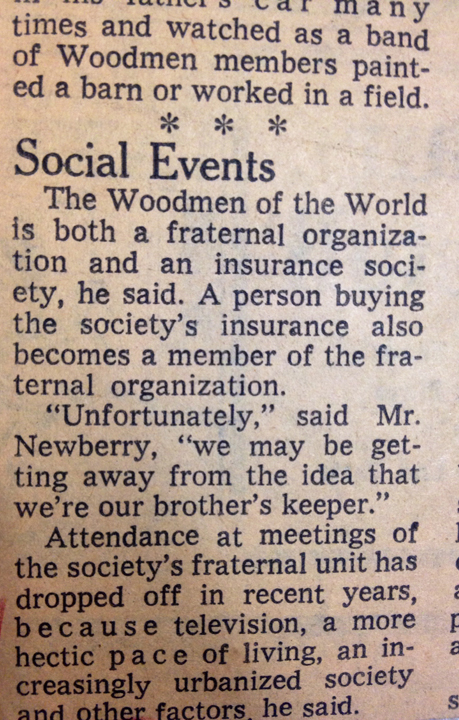
Those precious, little, worn, hand clipped OWH articles, highlighted with a red wax pencil not only were the toil of many librarians from decades past, but also held the clues to some of my mystery. Woodmen of the World was not just an insurance company, as I had thought my whole life. They were a fraternal benefit society.


Stepfather of Miss Cassette informed me later, that many fraternal organizations served to offer their members what we now consider employee benefits. Woodmen of the World Life Insurance Society was started by Joseph Cullen Root in Omaha. As a member of several men’s lodges, Root wanted to start his own society, inspired by a sermon, “pioneer woodsmen clearing away the forest to provide for their families”. A small ax became a symbol of clearing woods as well being of clear mind. I also found many references to the Modern Woodmen of the World, an earlier name. The organization built the 19-story Woodmen of the World Building at 1323 Farnam in 1912, later demolished in 1977. (Woodmen Tower is a 30 story building at 1700 Farnam St—last year it changed its name to WoodmenLife.) Most interesting to me, was that the head of the organization, was a small board called the Sovereign Camp. As the company-society grew in Nebraska, it spread to other states. Each state was called either a Jurisdiction or Head Camp. Local groups within Jurisdictions were called Camps, Courts, or Groves. This was getting good.
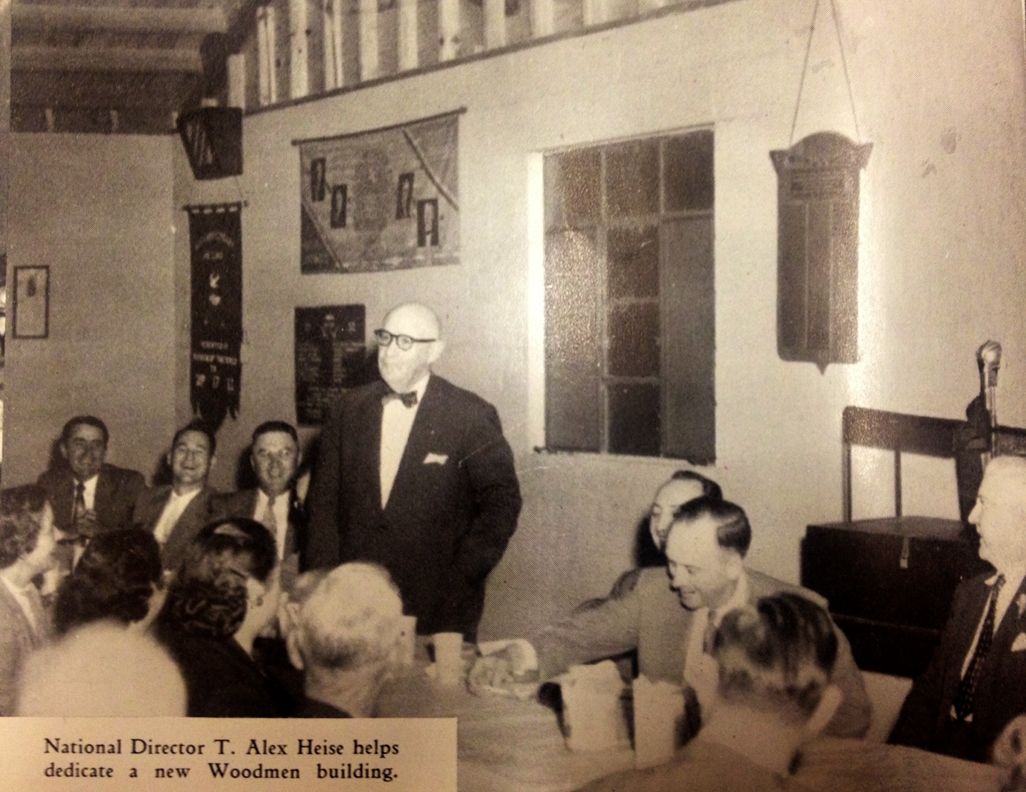
The W.O.W. lodges were spread throughout Omaha and its local Camps participated in good works, called “Fraternity in Action,” in their various communities, usually of a patriotic, Christian, charitable nature. They ran youth programs, particularly known for contributing to the schools through donation of monies and goods. W.O.W. raised money for city development also through real estate investments in local Camps and Jurisdictions. Although not named specifically in the clippings and brochures at the library, I was beginning to piece together what Benson Camp 288 might have been.
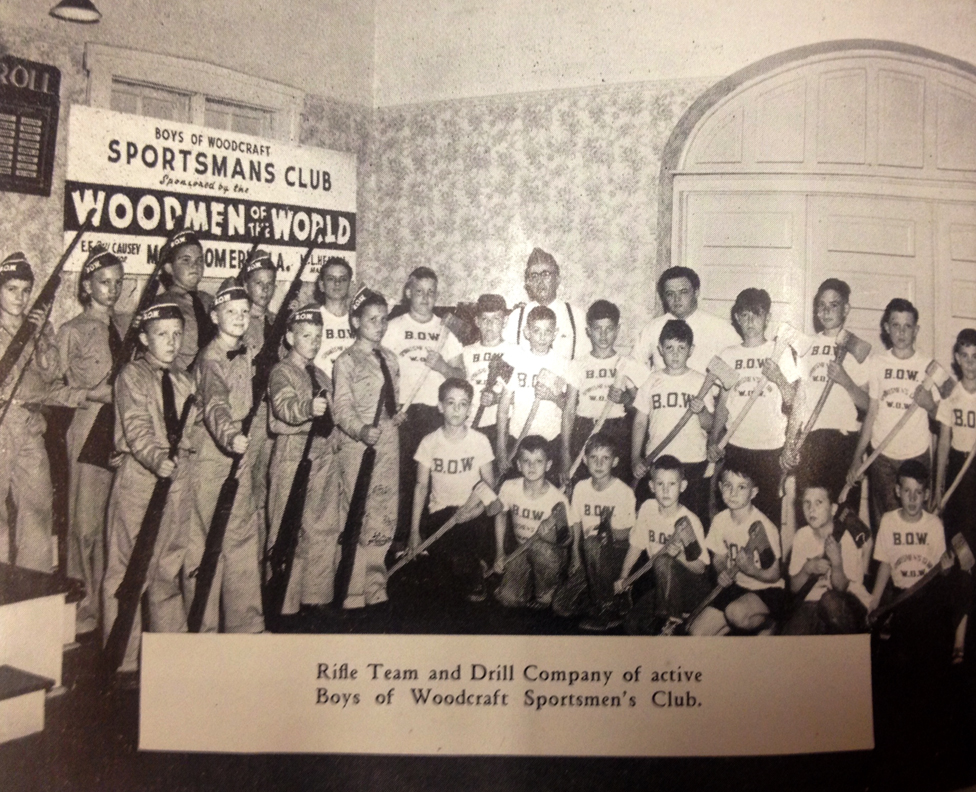
I unearthed plenty of compelling details about W.O.W. that I won’t go into here but I want to encourage you to look into the W.O.W. member Tombstones, their radio and television station, Neighbors of Woodcraft, Women of Woodcraft, Boys of Woodcraft Club, Soldiers of Woodcraft, membership restrictions and rituals. For more on W.O.W. and history of men’s organizations from this time period, check out this great blog I found a couple of days ago. http://freemasonsfordummies.blogspot.com/2016/03/woodmen-of-world.html

In my yearning for momentum, I began snooping through the library’s oldest books of Omaha clubs, lodges and fraternal organizations. None of these served to illuminate Benson Camp 288 any further. Not a mention. I again scoured through the city directories, this time searching for W.O.W. camps. The only connection I could find was the 14th and Farnam HQ building. It should be clear at this time that I was struggling with control issues and a serious lack of clues. I needed a break through. I, instead, decided to go home.
In the following weeks I would pore over many Omaha World Herald articles trying to connect the W.O.W. Benson Camp 288 to a mention of their potential 2501 North 61 Street lodge. It became more and more curious to me that other W.O.W. camps had their specific addresses occasionally listed in these lodge news articles but not the Benson Camp. Some of the articles mentioned a Woodmen of the World Hall in Benson, but not the 61st Street building. I also found that they met on occasion at the Eagle Auditorium in Benson. For the life of me, I could not understand why I couldn’t find a tie between W.O.W. Benson Camp and 2501 North 61 Street. If W.O.W. was such an upstanding organization, why wouldn’t the leaders of the Benson Camp have their name registered with the county assessor or the city directory?
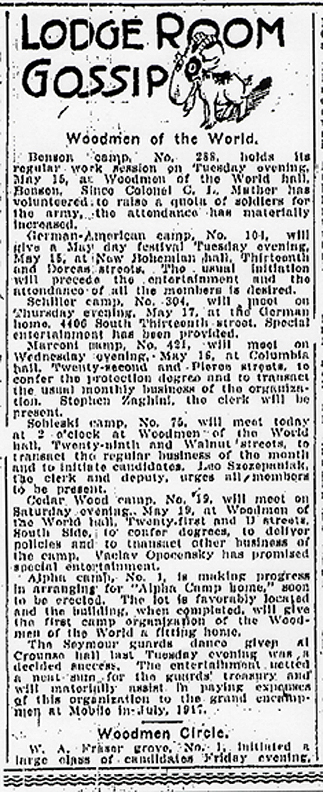
I printed off too many OWH articles to include but this article from May 13, 1917, illustrates the point I am trying to make.
Being the obsessive that I am, I decided it was time to place a call to the WoodmenLife Tower. I explained to the operator that I wanted to speak to their onsite historian or anyone with archival information about the various W.O.W. Camps. She explained that they “unfortunately don’t have anyone like that at the company” but thought Lisa in Public Relations might be able to help me. Could Lisa sense the pressure in my phone message that day and my need to authenticate the Benson Camp? I think she could. She did not return that call or my other calls placed to her office. Could I really blame her?
In my search for certainty, I began to look at all of the properties in and around 2501. I wanted to ascertain when they were built, as if that might indicate when 2501 was built. The house just north of 2501, currently numbered 2513, was built in 1957. The house directly behind the property was built in 1903. House directly south of 2501 was built in 1950. House diagonal was built in 1904 and the house directly across the street at 2504 was built in 1914. A quick survey of nearby, downtown Benson buildings on Maple Street, revealed similar construction years of 1910, 1909, 1912 and numerous from the 1930s.

Accepting that I was well past the supposed 1913 year of construction on the 2501 North 61st Street property without any kind of corroborating evidence to match the W.O.W. cornerstone, I again went back to the city directories to try to move forward. I knew my recent disappointment had only blocked my uncovering of new evidence.
Ice Station Breakthrough
On last inspection of the city directory, in the year 1934, the property had fallen off the record and was not even listed. By 1935 I found “Muny Ice Sta. No. 2” listed after the 2501 address. This same wording was found under 1936 and 1937. I was elated even though I didn’t quite know what that meant. Upon first viewing I thought Muny was, perhaps, a proper name but then I second-guessed it might stand for a municipal ice station. After a bit of research, involving interviewing Mother and Stepfather of Miss Cassette, I found more information about the ice station lead. Apparently in those days there would be an ice and refrigeration plant, which would manufacture and distribute said ice out to smaller, neighborhood stations. These ice stations would dispense ice to Regular Joes as well as deliver to companies. Saw dust helped to insulate these early ice stations.

July 10, 1921 From the Bostwick-Frohardt Collection at the Durham Museum. Metropolitan Utilities District Ice Station. “Several people picking up blocks of ice.” This is not a photo of station number 2 and it is only meant to illustrate what an ice station looked like.
I could find no newspaper articles specifically about the Municipal Ice Station Number Two or a direct mention of their 2501North 61st Street location. I did, however, find this brief mention in the Omaha World Herald (below) from this time period.

American Legion Chapter
In 1937 the American Legion Benson Post No. 112 and the American Legion Ladies Auxiliary took ownership of 2501. Finally (!) something I could sink my teeth into, I thought. The city directories were identical until 1961 when the wording changed to “Benson American Legion Hall.” This listing was the same until, oddly, in 1974, there was no address listed at all. 2501 disappeared from the directory from 1974-1978. By 1979 the address reappears under the name “Amer. Leg. (meetings). In 1982 the address stated, “Amer Leg Hall ‘side entrance.’” I found the American Legion listed until 1987 when the 2501 again went vacant. All in all a 50-year run housing the American Legion Benson Post No. 112. Impressive.

“Six members of the Benson American Legion Post. A large legion plaque is on the wall behind them.” Photographer William Wentworth September 12, 1946. From the William Wentworth collection at the Durham Museum Photo Archives.
I was able to find these fantastic photos through the Durham Museum. I was delighted to see the fireplace featured, a substantial, rustic stone hearthside. It reminded me of the fireplaces I had previously seen at the Elmwood Park pavilion and the Benson Park pavilion from childhood. Also visible are linoleum tiles on the floor. I figured the American Legion had added these tiles in the 30’s when they took ownership, as linoleum had been very popular then. I was unsure of when the fireplace addition had been made. The walls in the picture appear to be a painted plaster or some sort of cob mixture. The small windows that I had observed in my drivebys are seen in the women’s photo.

“Auxiliary Women’s Members of the Benson American Legion Wentworth.” Photographer William Wentworth. June 17, 1946. From the William Wentworth collection at the Durham Museum Photo Archives.
I wanted to know more about the American Legion Benson Post, in hopes of gaining more insight into these people and the building’s history. This group of Benson veterans were not handed their charter easily, in fact, they had to fight from the very start. The ex-servicemen originally met to organize the Benson post in 1927. Their application was rejected because the state department at that time limited the number of chartered post in Omaha, in order that Omaha Post #1 maintain a membership of 2,500. (At that time, the largest post in the world.) Unable to get a proper charter, they formed the Ex-Servicemen’s Club of Benson. In 1930 they again tried to organize, even appointing members to attend the state Legion convention. Their request for charter was again turned down at that very convention. It was suggested that the Bensonites form a divisional post. In the following years the group worked to increase its membership, still hoping to acquire a proper charter. By 1935 the Benson group convinced governing officials that Benson Post #112 should be allowed charter. For a year American Legion Benson Post #112, the little, persistent group that proved they could, moved their monthly meeting from building to building. In this time they jumped from the Community Center to the I.O.O.F. Hall, the Masonic Temple and the Benson Park pavilion.
In 1936 the American Legion Benson Post bought the building at 2501 North 61 Street. Their slogan was “The World’s Friendliest Post.” They sponsored small carnivals lasting for days, on site. They were also known for their large Veteran’s Day dinner celebrations. Membership swelled.

I was simply dying when I found this Post 112 photo. Note the handwritten door sign, “Bingo.” Love it. I also like the hanging lamp above the door.
In 1946 Post #112 opened a club, with restaurant, bar and slot machines on Saddle Creek Road. The club closed after slot machines were outlawed. Particularly known for their good works, the Benson American Legion volunteered with the VA, youth programs, Salvation Army and worked to promote patriotism. I found clues in the Omaha World Herald that the Post home at 2501 was openly shared with the Benson Community Council and the Benson Historical Society.

October 20, 1972 Annual Rummage Sale, Benson Women’s Republican Club
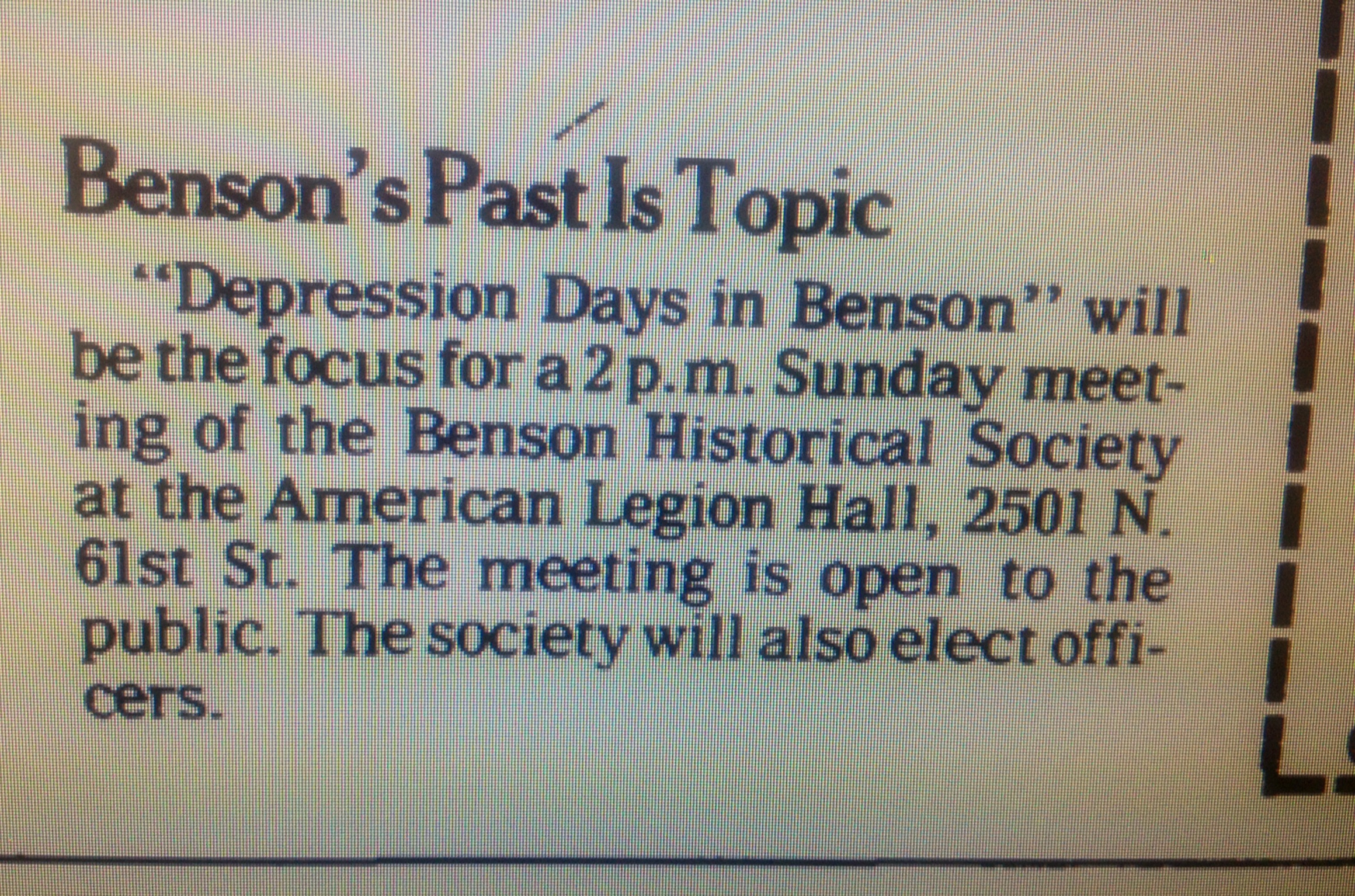
OWH ad for the Benson Historical Society meeting at the American Legion Hall. November 20, 1981

From the OWH on November 17, 1983
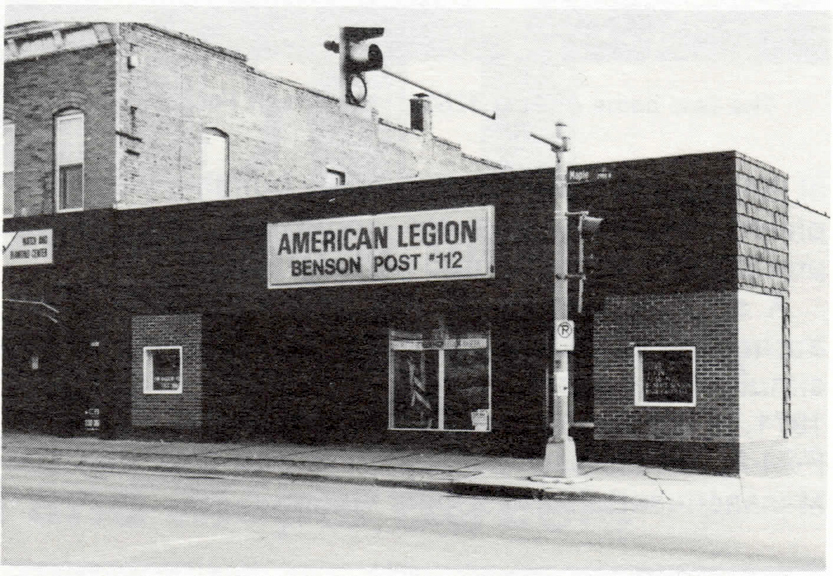
In 1987 the Benson Legion decided to relocate their Post home to 6125 Maple Street, currently another Brown Mystery Building next to Burke’s Pub and diagonal from the Waiting Room.
I found a single breadcrumb in the form of a November 5, 1987 Omaha World Herald article stating, “A request by West Omaha Day Care and Learning Center to open a daycare center for up to 60 children at 2501 N. 61 Street was withdrawn.” **Since the writing of this article, I have received information that 2501 was host to bands’ practice space, live music, parties and keggers in the late 1980’s and 1990’s. I am unsure if it was being rented out in these years or if someone with ties to the American Legion or future owners would lend out the space and/or throw these events.
Clarence M. Monich Clue
I hit the cold trail again, hoping to pick up clues where the American Legion left off. Apparently 2501 would sit vacant until 1990. The New Testament Christian Church was listed as having bought the building, in that year, presumably for services. I couldn’t find anything about the church group but was able to find a real estate transfer on July 12, 1990 from Benson American Legion Post 112 to Clarence M. Monich. The building sold for $36,000. I wondered if Clarence M. Monich was a minister of sorts? I cannot say for certain his affiliation with the church. Probing further into the life of Mr. Monich, I found Clarence Monich was president of the Benson Community Council, one of the city’s oldest neighborhood groups. In 1991 the council became the Benson Neighborhood Association. Previously he was the city-county health sanitarian or sanitarian with the Omaha-Douglas County. Mr. Monich was in local newspapers frequently due to his job. I found so many articles where he was interviewed. Mr. Monich regularly held Benson Neighborhood Association meetings at the American Legion on 61st and Maple. Why not at the 2501 N. 61 Street location? I was confused. Mr. Monich surely held Benson Community Council meetings at 2501 when the American Legion owned the building. I had newspaper articles to that effect. Maybe he was also in the American Legion. Perhaps 2501, under Monich’s ownership, was only being used for church services.
I tried to find Clarence Monich’s information to make contact with him. I was hitting roadblock after roadblock. He would be 96 years of age now. I later found, according to the Catholic Voice, Clarence “Mick” Monich had died at age 73 in 1994.

Somewhere in this time frame I approached Mark, one of the best downtown librarians, if not The Best, about my frustration with this case. The lack of W.O.W. information was still perplexing. Mark admitted to having tried to investigate this property as well, in the past, which I thought was funny. How many of us have banged our head against the wall about 2501 North 61st Street? He had not gotten anywhere in his own search. He brought out a commemorative Woodmen of the World book from the archives, which I hungrily inspected. Unfortunately there was nothing there that I could use. He suggested that I contact Ann Van Hoff of the Benson Historical Society. Mark informed me that if anyone would know the answer, it would be Ann.
Ann was very nice to email me back. She knew of a IOOF – International Order of Foresters that met on 61st and Maple but was unsure of the 2501 North 61 Street property. **Since this article came out, Miss Cassette has learned that this I.O.O.F. stands for Independent Order of Odd Fellows.** Ann thought it had been a residence in recent years. Ann did mention she thought there was a centennial book on Benson that the library would have. I checked again with the library about any Benson books. They did not have this book Ann described in her email.
Rosemary Parenteau Clue
I continued on with my newspaper exploration. I found a February 6, 1994 real estate transfer from Clarence M. Monich to Rose M. Parenteau for $33,000. This was the year that Monich passed away. In the mean time, I found it odd that the 1991-1994 city directories had 2501 listed as “vacant” again, even though Monich had been the owner until 1994. How had he kept his name out of the record or was it a mistake?
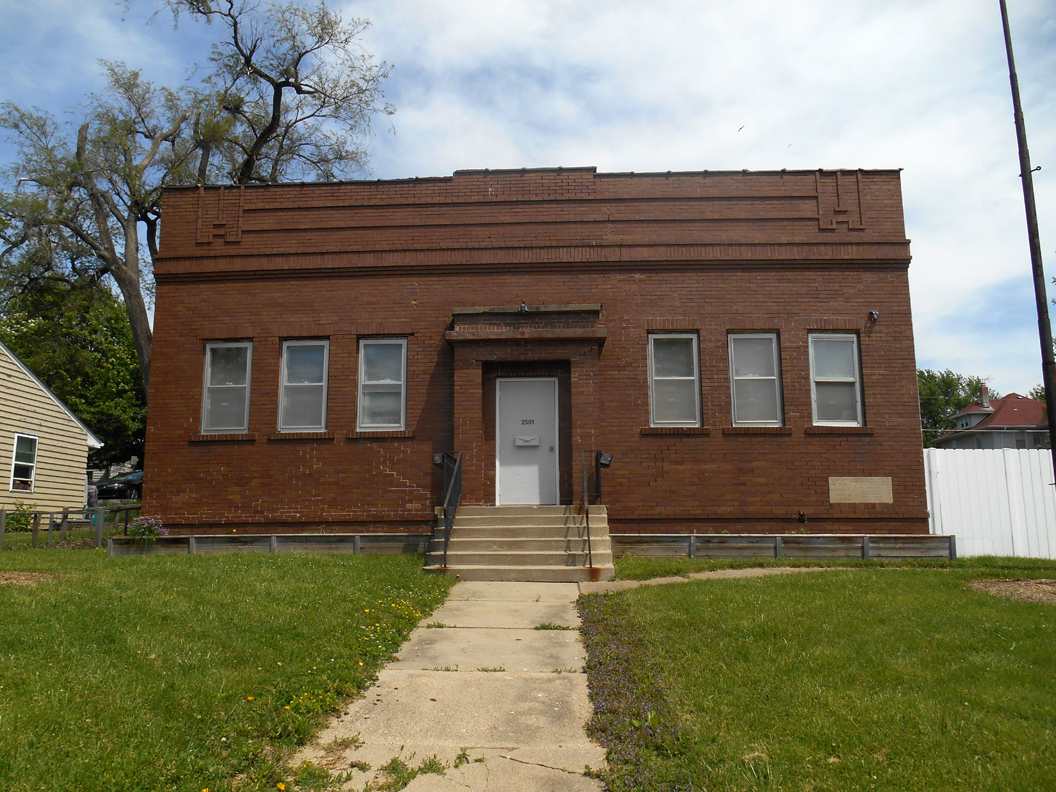
By 1995 the city directory listed Rose M. Parenteau as the owner of 2501. I found Rosemary Parenteau’s name listed as a Benson Community Council President in the 1980’s. She must have known Clarence Monich from that position. I could find no evidence to link the Benson Community Council to the property at 2501 North 61st Street. From what I could find, the property was used as a “storage” building in those years. Parenteau was also an active member of the Benson Historical Society. I tried to find Rosemary or a Rose Parenteau in Omaha, hoping to contact her and ask questions about the building. Through the https://omahaobits.wordpress.com/ website, I learned that Rosemary Parenteau died in 1996 at age of 72. Her husband who had been a veteran, Joseph Parenteau, died in 1959. I could see an American Legion, Benson Community Council and Benson Historical Society connection. I do wish I could have spoken with these two community leaders as they surely had a wealth of local information.
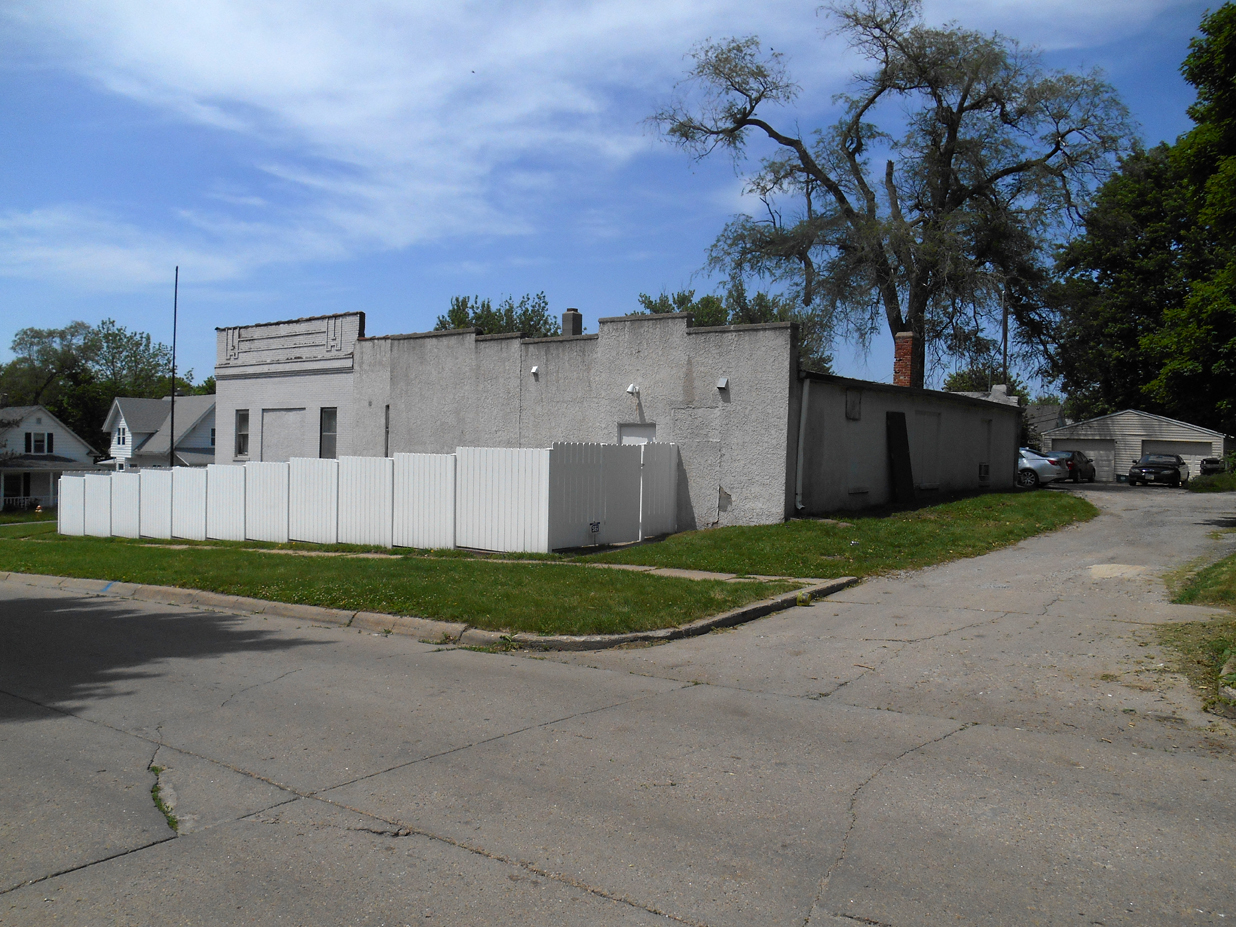
Southeast side of the lot, from Lake Street.
The 1996-1998 city directories listed 2501 North 61st Street as “not verified” which typically means they were not sure of the status. But another query of mine found that 2501 had been sold on October 2, 1996 for $35,950.00. I could not find the owner until I stumbled across a police report filed on April 29, 1997 for 2501 North 61st Street, which stated” Inspirational Multi-Culture Center had 20 rolls of wallpaper stolen.” I figured the Inspirational Multi-Culture Center, had bought the property. Why, then, was there no address even listed for the property from 1996 until 2009? Untraceable. Apparently for some time period, people could rent out the space for parties and people are rumored to have attended kegs at the building. Was this during that period? Did the church group own it but were renting it out?

Northside of property. Notice three windows have been filled.
According to my contact, Trina, at the Omaha City Planning Department, 2501 North 61st Street was surveyed in 2002, although she could not find any photos had been archived. I tracked down this Reconnaissance Survey of Selected Neighborhoods from April of 2002 and found in the Inventory of Surveyed Properties of Benson that 2501 was, indeed, listed as a “settlement” in their report. This labeling was curious to me. This is important because not all homes and businesses make the Reconnaissance cut. Historic Benson and adjacent neighborhoods, including surveyed properties mentioned in the report were considered to have a “significant amount of historic preservation potential.”
Recent Owners
I had already pieced together from the county assessor and the real estate transfer I found Justin Limoges had bought 2501 for $68,000 in April 30, 2007 from Inspirational Church Inc., although I couldn’t find his name in the city directory until 2009. As you are certainly figuring out by now, this story and its clues simply could not be nice and tidy, the way Miss Cassette prefers. Apparently Limoges bought the property wanting to create a home/photography studio. Because of the condition of the building and the great time and expense, it became a much bigger project than he had planned.
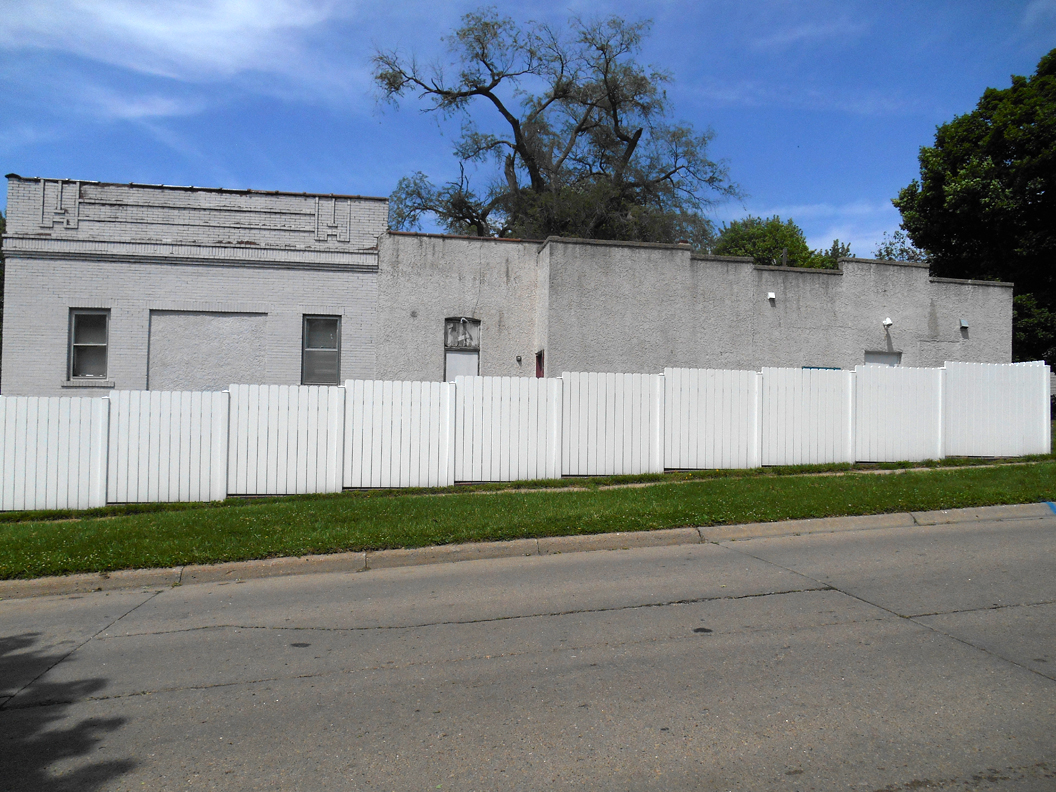
Limoges just recently sold 2501 North 61st Street to its newest owners, the couple who are friends with my friend. They are planning to make the property into a live and work studio as well. Having studied at the Chicago Art Institute as a figure sculpture and painter, they believe this large one floor building will easily support those activities. The couple loves Benson, stating, “It reminded us of the neighborhoods we lived in Chicago.” They have already started documenting their rehab journey in their cool blog http://wowbensoncamp288.blogspot.com/. Check it out. What follows are some interior shots that they have photographed since taking ownership.

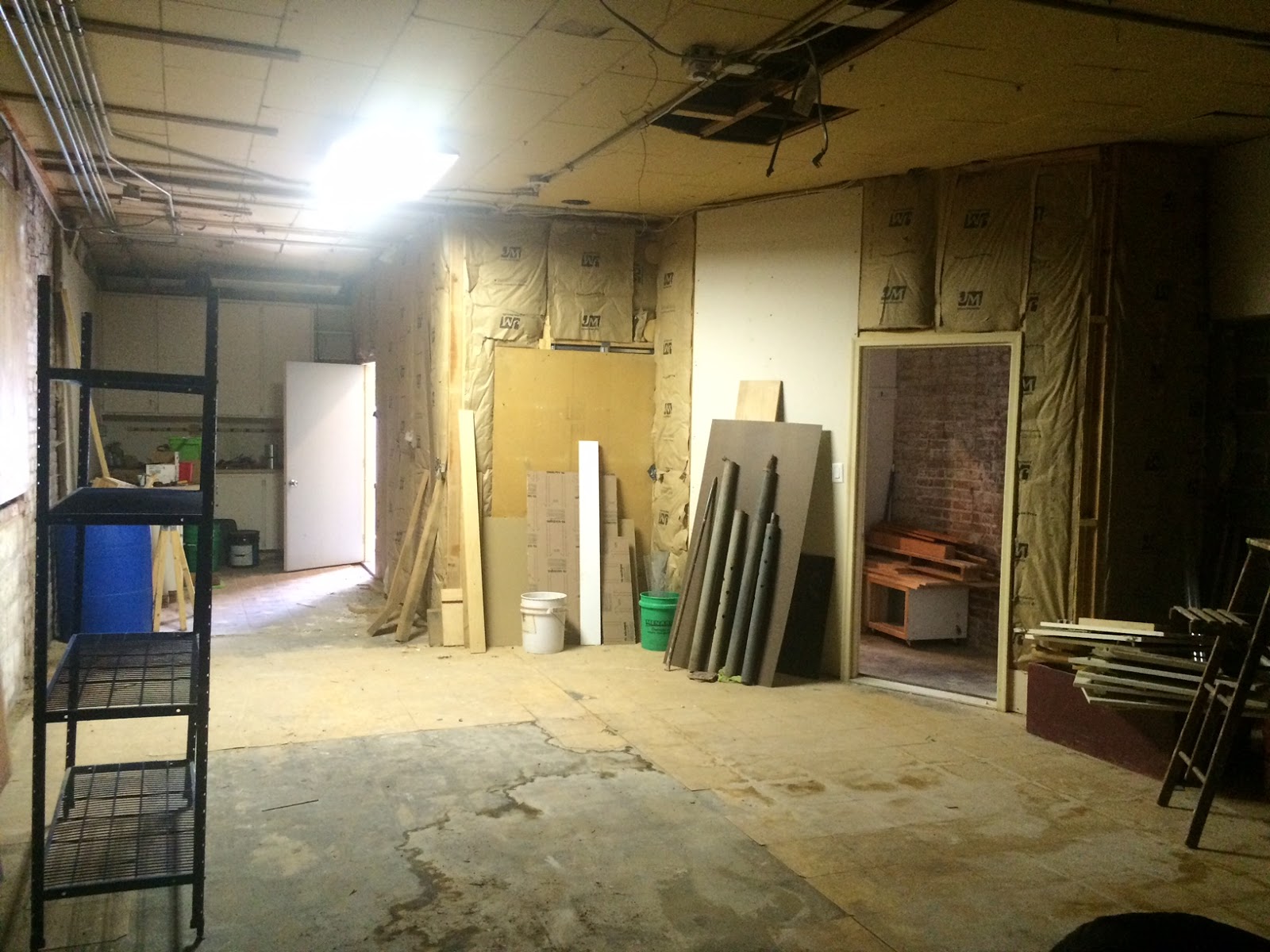

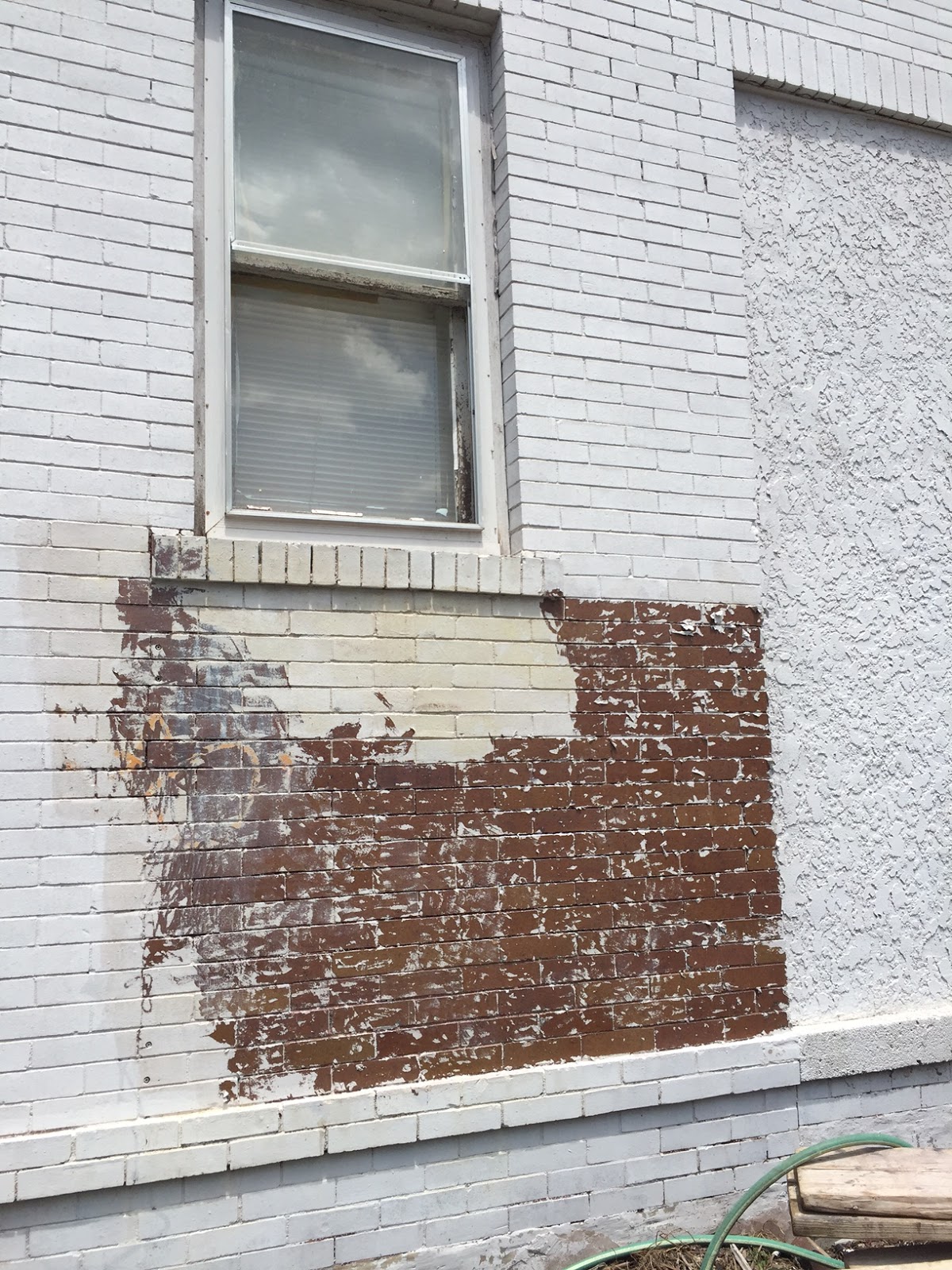
The new owners were able to verify that the “fireplace is massive – maybe 12 feet across – and made out of some type of brown stone.” I thought it looked exactly as it did in those American Legion photos. The fireplace is located in the “back of the building on the north side adjacent to the old kitchen where they prepared meals, maybe from when it was a church.”
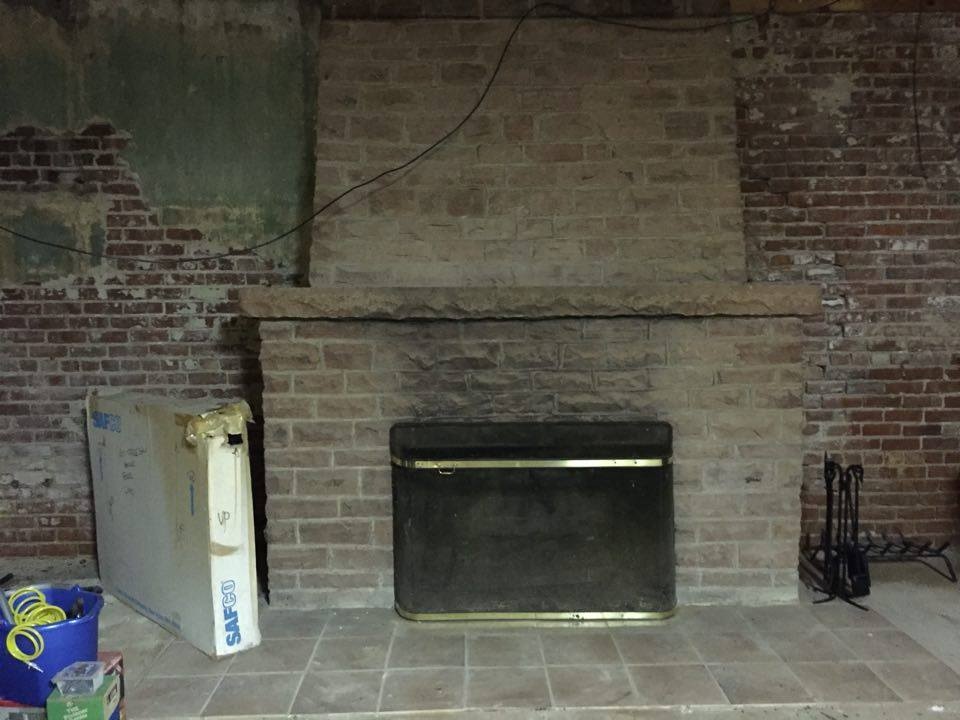
Fireplace in its current state. Notice they have taken the plaster off the walls. New tiling since the 30’s linoleum.
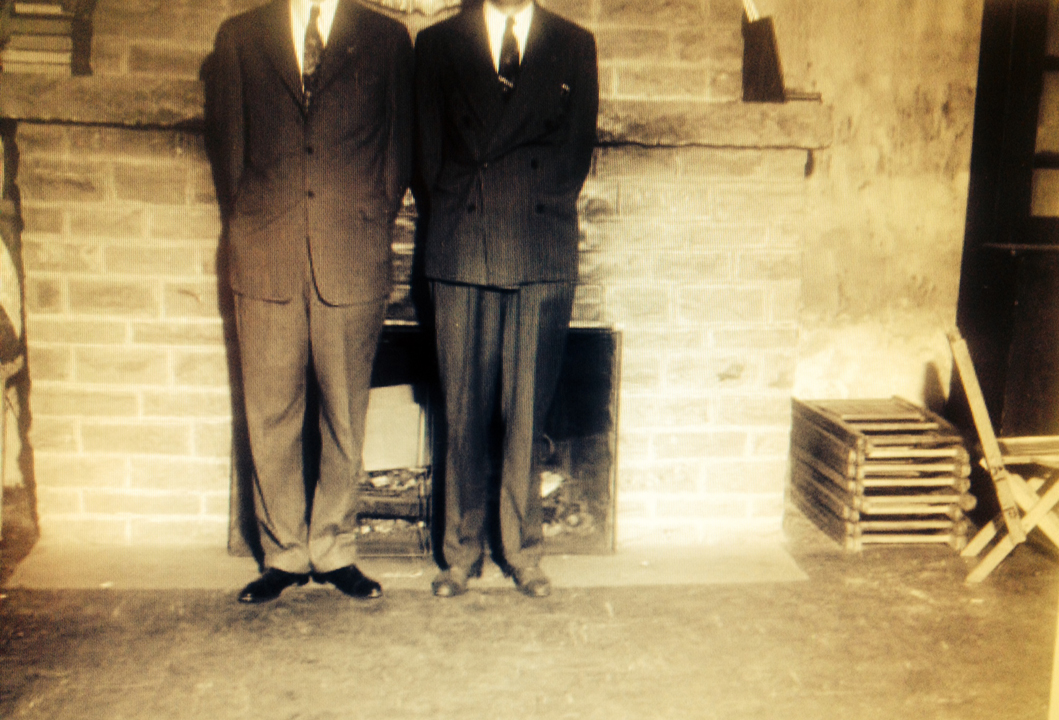
The fireplace as seen in the 1930’s.
There is in this blog entry one significant omission, one article, one bit of evidence I needed and never found: what was the address of the Woodmen of the World Benson Camp 288. Was it really 2501 North 61st Street? It was slowly driving me mad. I was told by Lynne, another great Omaha librarian, “There are some things you just can’t know and can’t find. Not everything was documented back then.” I understood her words but I couldn’t accept them.
I began digging through my Omaha books at home. There are too many, too many to even remember at times but on this night, I was fed up and I was on a mission. I found I did have a book on Benson that I had forgotten I even owned. Was it the Benson Centennial book that Ann Van Hoff had mentioned? I could not believe it. It was called Benson, Nebraska 1887-1987. I flipped to the index. Oh, I was so hopeful. Under Woodmen of the World Benson Camp, I found they were given only a three-sentence summary, again eluding the location of their lodge. While backtracking to the American Legion Benson Post 112, I came upon the most shocking of shocking news. The case finally broke clean open.
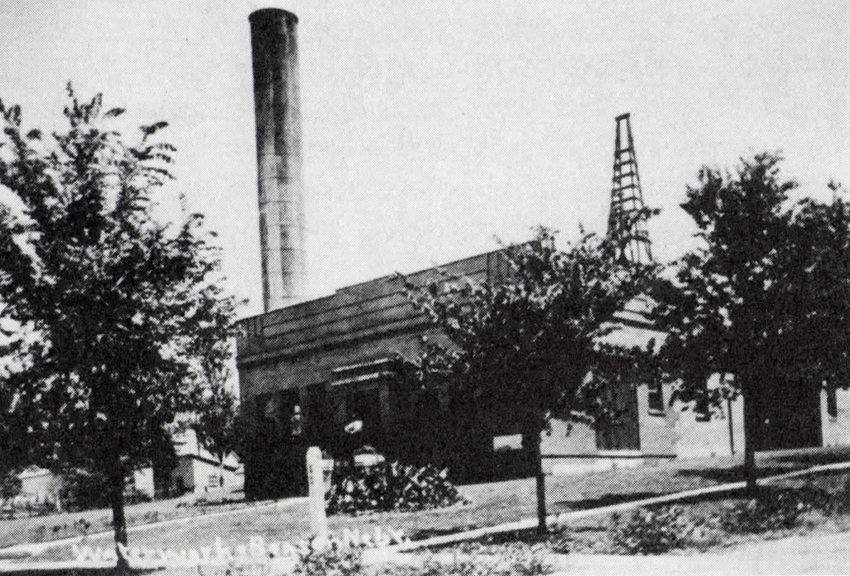
White handwritten font reads “Waterworks-Benson Nebr.” Notice large tower to the left and cylindrical framing of a tower to the right.
The Secret Benson Waterworks Building
2501 North 61 Street was built in 1906 and was the Benson Waterworks Building. In 1905 Benson voters approved the $20,000 bond issue for the building and necessary machinery. Opposite of what I had previously assumed, the original building is the back stucco portion of the property. There were thought to have been multiple additions over the years and was built in several sections. There was also a 100-foot water tower to the north of the structure. Mr. Hansen was the water commissioner and a virtual one-man show, who not only operated the plant, but also handled all billing and even made repairs. I suspect that the brown stone fireplace in the back most corner of the original building was used in some capacity for the Waterworks or that Mr. Hansen could have possibly lived on site. The Benson water rates were lower than Omaha’s and the water quality thought to be far superior. I found it humorous that Bensonites were encouraged to bring their own drinking water if they would be “spending much time in Omaha.” The water was described as cool and sweet and Bensonites were rightfully proud of the purity of their well.
Mr. Hansen acquired a new air pressure pump in 1912, which increased Benson’s water pressure. The Benson Times quoted Mr. Hansen saying he “could get enough water to float a battle ship inside of an hour.” By 1913 more bonds were approved to build an addition to the Waterworks as well as install a triplex pump. The cornerstone of the Benson Waterworks building was one of the last additions to the building. I believe that Woodmen of the World Benson Camp helped raise monies for the building of this last addition of the Benson Waterworks. This was one of their many good works, community minded projects. I began to think that maybe they were invited as an important local organization to conduct the ceremony of this new building, obviously seen as progress in Benson. I do not believe that Benson Camp 288 had a lodge at this property.
The Benson Waterworks stopped operation in 1917 with annexation to Omaha. Benson residents continued to complain about having to drink Missouri River water and the poor water pressure for decades to come. I will include this next piece of history in a direct quote as proof that you cannot make this stuff up. It does not get better than this. “After the Waterworks building was abandoned, it was used to grow mushrooms until the Benson American Legion acquired it in about 1937.” I could not believe it. That explained why the city directory had the address as vacant or no address from 1918- 1937. They were growing mushrooms in there? The triple punch was that Rosemary Parenteau was a co-editor of the Benson, Nebraska 1887-1987 book. That point still touches me.
To say I was blown away would be an understatement. I went running down the stairs to tell Mr. Cassette I had solved the mystery only to find him asleep. I had been chasing after the Woodmen of the World Benson Camp for so long, I didn’t know how to feel about this curve ball. Ultimately I was delighted because 2501 North 61st Street became much, much more important in the scope of Benson history. If only the Reconnaissance workers had known they were looking at the historic Benson Waterworks building. That and the fact that 2501 was built years before that tricky cornerstone would have one believe. I lay in bed that night staring at the ceiling, unable to sleep, thinking about what that cool, sweet Benson water must have tasted like.
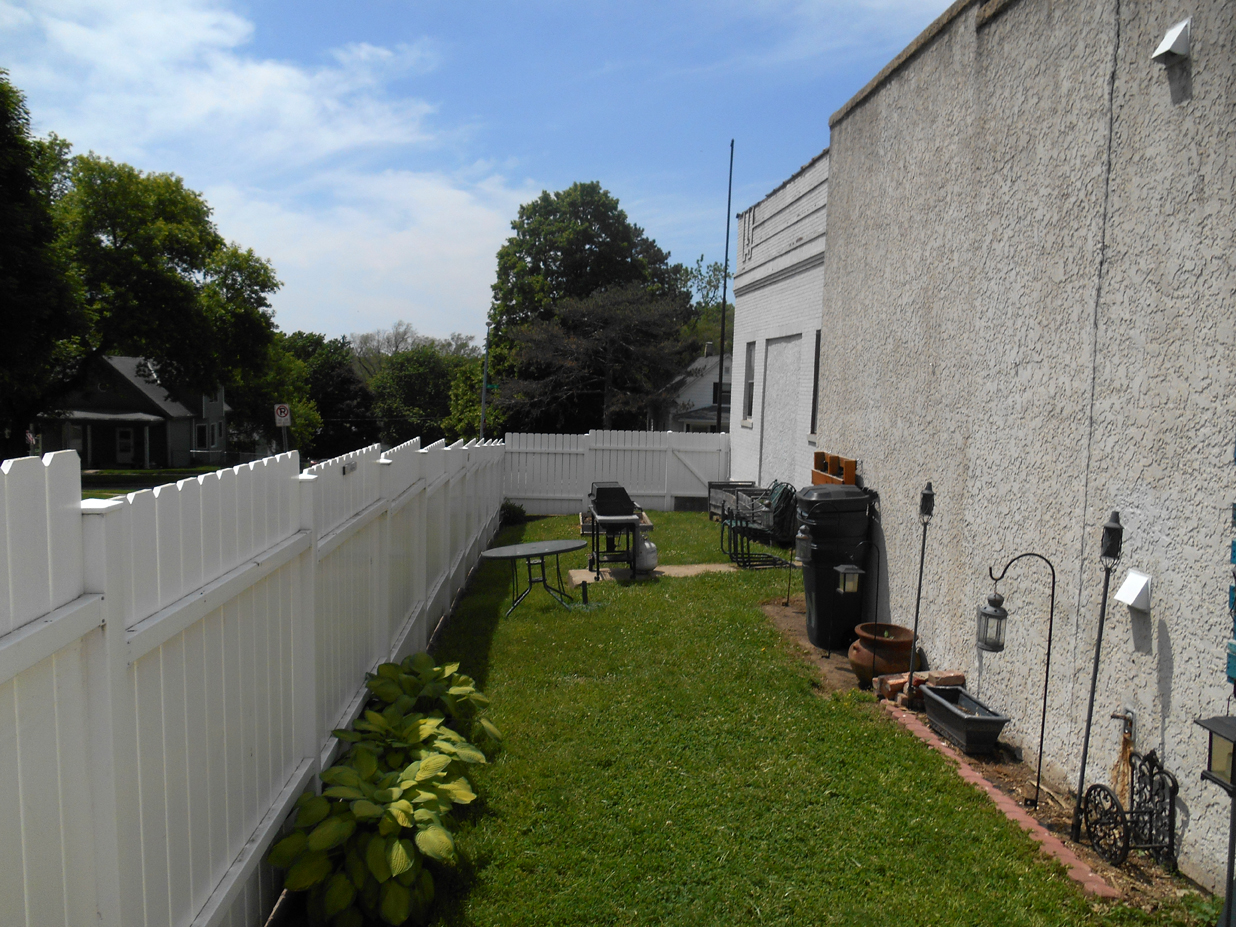 Small, southern side yard running the distance of the building.
Small, southern side yard running the distance of the building.
I have had so much fun investigating this story. I would love to read any comments that you would like to share about this amazing property and Benson. To enable comments and also to be able to read what others have written, please click on the header title. If you would like to contact me personally regarding news about this property or Benson history, please feel free to write at myomahaobsession@yahoo.com. Thank you for reading my blog.


© Miss Cassette and myomahaobsession, 2016. Unauthorized use and/or duplication of this material without express and written permission from this site’s author and/or owner is strictly prohibited. Excerpts and links may be used, provided that full and clear credit is given to Miss Cassette and myomahaobsession with appropriate and specific direction to the original content.
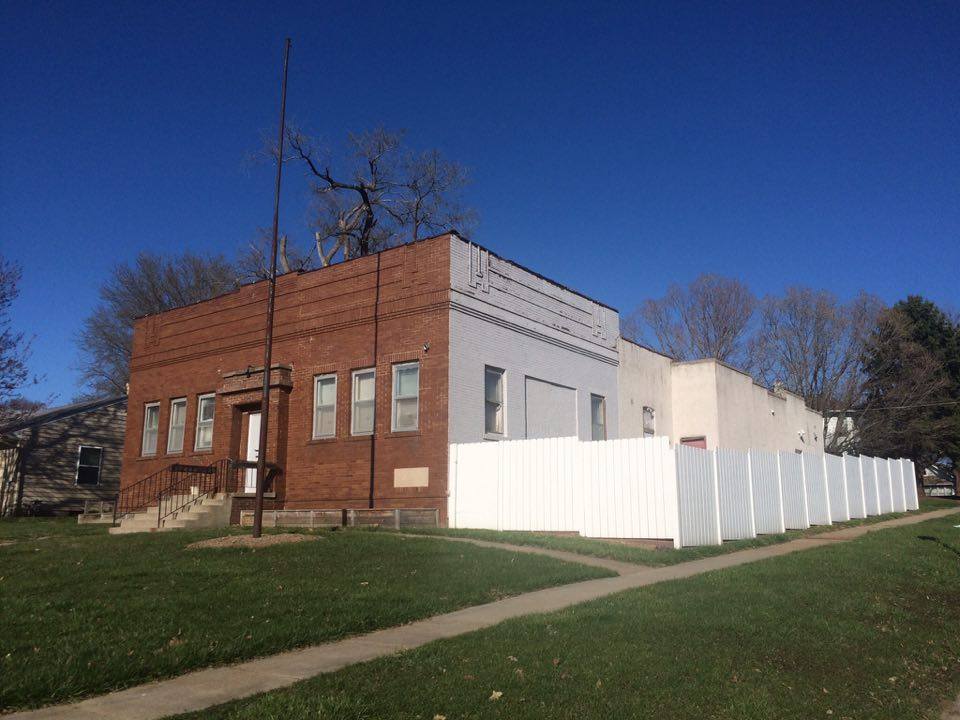
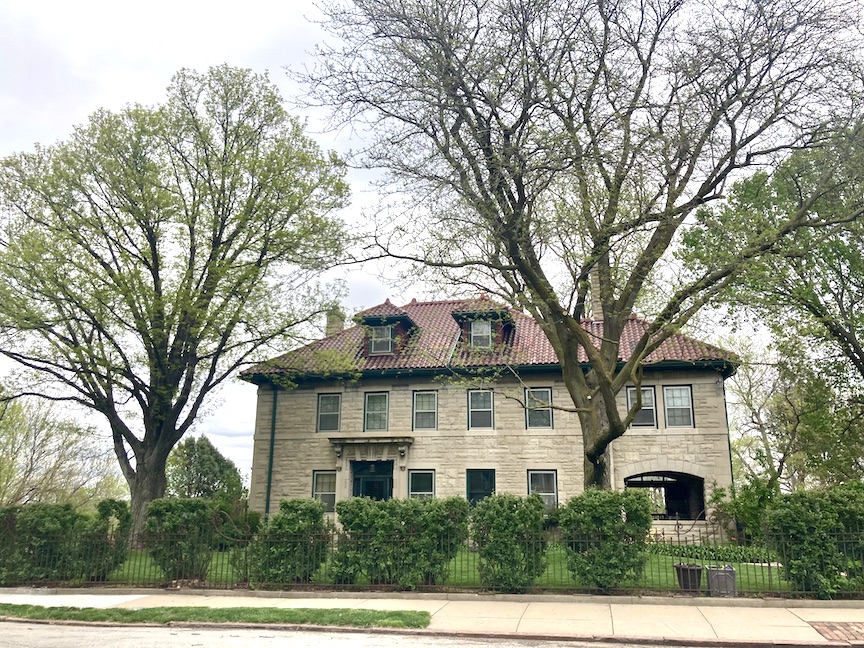
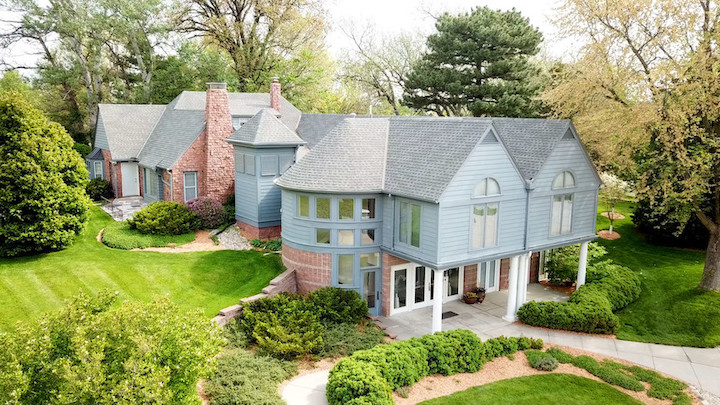
Oh, my! What patience, Miss Cassette! My head is swimming from the search.
Truly amazing! I loved following you on this journey! This particular mystery really shows how things may not always be what they seem. It’s almost as if this building’s history didn’t want to be discovered. Congrats on finding it out anyways!
Hello Michele,
Thank you! That really means a lot to me. This was quite a challenging piece for me, on a number of levels. I thank you for your comments. Take care
Thank you so much…I greatly appreciated reading the results of your obsession! I was pointed here from the Forgotten Omaha Facebook page where I had inquired if anyone remembered if this was the building where on Friday nights young teens could pay 50 cents or so to attend a dance there and a gentleman…don’t know who…would give dance lessons for things like the Stroll, the Merengue, etc. I think I was in 6th or 7th grade so this would have been around 1960-61-62ish, but I’m having a hard time remembering the specifics. Anyway, really enjoyed the fruits of your labor!!!
Wow! That is amazing. Do you think this was the building? What a great memory. I was tipped off by another reader that there might have been a stage inside? Does that ring any bells? Dance lessons. That is fabulous. I hope someone else shares more info with us! Thank you for your comment.
Yes, I’m fairly sure this was the building. My husband and I drove around that area Sunday afternoon to see if I could find it which we did, even though it was all pretty hazy in my memory. At least one other person on Forgotten Omaha also remembers these dances there now too. It’s good to know I didn’t fabricate all this in my own head…ha!
Certainly not! One thing I have noticed about getting older is that people take my word for things (nice) but I am noticing there are less and less people to find who can verify facts (sometimes sad). So I do appreciate you sharing this as a very important piece of the history puzzle.
It is sometimes difficult to chase down the facts….your work on this building is certainly evidence of that! You asked about a stage. I honestly don’t remember one, but that doesn’t mean there wasn’t one at one point or another, of course. If I hear any more from any source, I’ll be sure to let you know.
Thank you!
I sent this article to my mom and dad. My mom said that she took ballroom dancing lessons there in the early 1960s.
So amazing! Thanks for sharing.
Very Nice article.
My family was involved with that building beginning in 1968 through 1988.
My brothers and I where in Boy Scout Troop 7 that meet there every Wednesday evening. My dad was a member of that Legion Post at the same time. I also had my weding reception there in 1986.
I dimly remember seeing a picture of that building with the water tower in the background so was aware that it had been a water works.
My folks tell me they where told that mushrooms use to be grown in the basement and some of the water works equipment may still be there.
My folks also knew both Clarence and Rose
Ron, this is great! Thank you so much. I have been yearning to hear some stories about the place. The mushrooms were a real curve ball. I am sure some of the findings within the building will be viewed differently now. So cool! Thanks for sharing your memories.
It was good for Mushrooms due to the damp conditions of the water works.
BTW the basement was filled in with dirt a very long time ago.
All though the machinery may still be under there.
My Dad who was in construction did a lot of the remodeling during our time there and at the next location on Maple St.
I knew it would have been perfect for mushroom growing. I was delighted by it. When I was a child I wrote about a girl detective thinking a jewel heist was taking place underneath an NYC jeweler’s shop when it was really a family growing mushrooms in the basement. So this popped into my mind when trailing this Benson mystery. Odd. Good to know about the basement. I thought you might have been confused as there isn’t one—but you do, indeed, know your stuff! Thank you, Ron. Please let us know anything you think of. The new owners will love this.
Do you have any information on the stained glass windows installed at St. Mary Magdalene church on 19th Street?
ONE TRUE LIGHT:
http://www.lulu.com/shop/robert-klein-engler/one-true-light/paperback/product-22696789.html
Hello,
Unfortunately I do not know the answer to that right off. I might know some friends who could tell you. Let me look into this. Thank you
I very much enjoyed reading of your investigation, and have lived in the surrounding neighborhoods since I was a toddler in the ’50’s… That property always intrigued me, as well.
Thank you, David. You must have quite a few stories also. What a great part of town!
One of your best, which is saying a lot! So well illustrates the problem of addresses not following the rules. 🙂
The library does have the Benson centennial book, by the way–two copies in the Nebraska Reference collection downtown and four circulating copies.
Thank you! Yes, such a cool book. I found it used at Jackson Street but since have found it at the library. I am learning!
Sorry, forgot to give the catalog link: https://omaha.bibliocommons.com/item/show/1029776060_benson,_nebraska
Interesting story. Thanks for all your hard work! I can add just a bit. I grew up in that neighborhood. From the age of 12-15 or so, I attended dances at that location every Friday night for years. It would have been between about 1960 thru 1965.
It was for kids, of course. It was a lot of fun and I have no idea who put it on. But, as I recall, the building was the American Legion Post, as you discovered in your research.
The front room pictured on the floorplan you found was the hardwood floored dance-floor and the back, actually a bit larger room was for socializing and refreshments served from a counter and pass-thru on the south wall. Refreshments were soda pop, of course. The guy that ran it played records, the pop music of the day. Bobby Vee, Dion and the Everly Brothers. We all learned to dance and interact with the opposite sex right there on those Friday nights. It holds very fond memories for me. Thanks again for researching.
Wow! What a wonderful article! I grew up a block over on 60th Ave between Lake and Miami in a lovely old home built in 1910. My family moved there in 1990 and my mother still lives there. I always wondered about the history of the building as it always appeared to be vacant during my childhood of roaming the neighborhood. It also seemed out of place to me in the middle of our neighborhood, which drove my curiosity. You have solved 28 years worth of mystery for me! Thank you! I cannot wait to read more of your articles now that I have discovered your blog.
Thank you so much for your kind comment. It really was a rabbithole for me but Now We Know!
Thank you for uncovering this information . I live an eyes view from this building and have always been curious if it’s history . I have been inside a few times and have heard of some of its past, as you have uncovered. Our neighborhood kids played outside there a lot and they called it the church.
As I can now see , It has so much rich history . As I look at it daily now I will see it differently .
Thank you for educating us on its past.
Just wondering… Did you check the possible north side address on Lake Street? 6099 Lake or whatever?
What a phenomenal article. I live in Benson and always wondered what this building was when I’d walk past it. Now I know!
Hello! I wish I knew about your investigation when it was on going. I might have been able to help! My Great-Grandparents resided diagonally across the street from this building at 2348 North 61st Street. They were Theodor C. and Edna M. Johnson. They moved to Omaha during the depression, and lived there the rest of their lives, each passing in the early 1970s.
I have many great childhood memories with “Grandpa and Grandma John” during the 1960s! One of their summer pastimes was to sit on the front porch during the evenings to watch the world pass by… Back then, Grandpa had much more seating on the porch, and many of the neighbors would stop by to visit. The America Legion Post was in full swing, and I remember many events; bingo, wedding receptions and such at the building. My Grandparents and their neighbors would delight in seeing everyone in their finery coming to these events!
My Grandparent’s 50th Wedding Anniversary was celebrated at the Legion Post in 1959, and I was told that this event was also the celebration of my baptism that same Sunday. So you can see that this neighborhood and the Legion Building was a big deal to our family at that time.
I was aware when I was a kid that the building was the former Benson Water Works, and as a kid, I recall the foundations for the water tower or something which had once been there in the past. The fence was not there on the south side of the building then. The square indentation on the south side, between the two windows was a stucco wall, and had a very large, full color American Legion emblem painted there. One of your photos, with the sign reading, “Benson Post 112” and “Bingo” is how I remember the place, and was likely taken during the mid to late 1960s.
My last time in the building was in 1978 or so when I attended a meeting of the Benson Historical Society. Life moved on. My Grandparents passed away in 1971, and Mom and I moved to California, but we moved back to Kearney, Nebraska in 1974. After I graduated from high school, my parents moved back to Omaha, and I grew up and served in Law Enforcement in Douglas County until moving to Kansas City in 1994, where I remain today. My Mom passed away at Lavista in January 2023 at the age of 93.
Like you said, kids growing up in our day marauded over the neighborhoods and knew where EVERYTHING was. If you’d like, perhaps someday we might share a phone call or a cup of coffee and we could compare notes about the old neighborhood.
Thanks for bringing back many great memories!